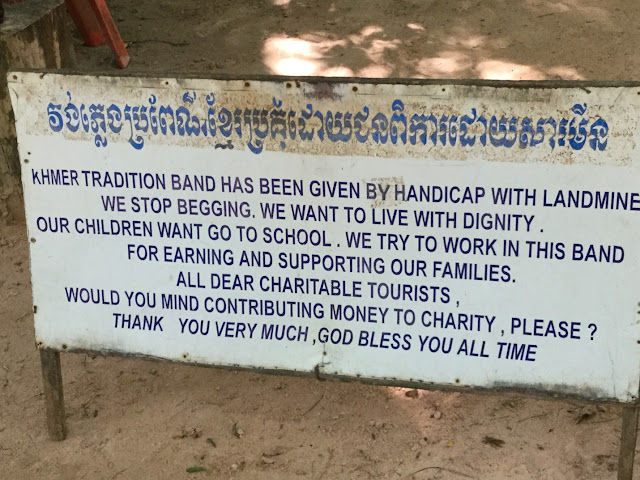.
In the morning of our first full day in Cambodia, we went to the Angkor Thom Complex.
It was in the NW part of the map of Cambodia below

It was built later than Angkor Wat, during the 37-year-reign of the god king Jayavaram VII from 1181--1218. He was a fervent Buddhist, which was unusual, as only one king before him was. It was the last and most enduring capital of the Khmer empire, and the center of the king's massive building program. When the king died, construction stopped. Angkor.means "city" and Thom means "big." It is 12 square kilometers in area,4.6 square miles
In the morning of our first full day in Cambodia, we went to the Angkor Thom Complex.
It was in the NW part of the map of Cambodia below

It was built later than Angkor Wat, during the 37-year-reign of the god king Jayavaram VII from 1181--1218. He was a fervent Buddhist, which was unusual, as only one king before him was. It was the last and most enduring capital of the Khmer empire, and the center of the king's massive building program. When the king died, construction stopped. Angkor.means "city" and Thom means "big." It is 12 square kilometers in area,4.6 square miles
After we got out of the bus, vendors abounded to sell us items.
We crossed a bridge over the river to get to the main gate.
On each side of the bridge were guardian statues, apsaras (angels) on the left
and demons on the right (below), to create a good guardian balance.
The previous style had been of birch, but here sandstone was used. During the long wars with Thailand, the bridge walks and statues were used for target practice. :There are bullet holes on the statues as well as arms and noses shot off.
The big gate beyond the bridge and moat, with an introduction to the multi-faced heads.
We saw and our guide Newat explained a machine the Khymer used to raise the heavy stones and put them in place. Newat was delightful, with a smooth baritone voice. He grew up and lives in Siem Reap and saw the changes to the area as the country came out of the deadly Khymer Rouge rule and saw this area opened and developed for tourism starting a bit over 20 years ago. Note the holes in the stone blocks. They were key in lifting the blocks into position.
 |
| With Albert from Vancouver, BC |
More stones piled for future use--like a gigantic jigsaw puzzle.
The reconstruction in this area, especially the Bayon area, is being done by Japanese, officially Japanese-Apsara Safeguarding Angkor.project. The Japanese after over 20 years working here may pull out in 2020.
From there, we reboarded the bus and road closer to the Bayon, the center of which was Jayavaram's state temple. There we saw 49 magnificent stone towers, each with four huge faces and five more around the king's palace. I remembered how magnificent these were from my previous trip almost 6 years ago.
This area and Angkor Wat were declared parts of a World Heritage site in 1992. Just since 1998, it has become a popular and safer place to visit.
This king had cared greatly for his citizens and workers and built 200 rest houses and over 100 clinics here for the million people who lived here, maybe both inside the moat and walls and outside close by. This king was a moderate Hindu and included Buddha statues but his successor had all of them removed. We saw niches where some had been.
So much more work needs to be done, but with the Japanese pulling out, it is not sure who will step up to take their place..
Lots of uneven stair climbing--careful Havazelet!
As we got higher and higher, we could see the amazing details of these heads.
Many members of our group had their picture taken here at this window.
We were lucky to get to the top level because in 2020 it will be closed for restoration and may not reopen to tourists in the future.
These were truly awesome!
Our guide Niwat took our pictures here, nose to nose. Sam's was the best that I saw!
Outside of this area, we passed by several temples under construction and a huge wall called the Terrace of the Elephants created centuries ago of discarded pieces of construction. It is part of the walled city of Angkor Thom, the last and most enduring capital of the Khimer empire.. The terrace was used by Angkor's king Jayavarman VII as a platform from which to view his victorious returning army..
At the western entrance of Angkor Wat stands a 5-meter-tall statue of Lord Vishnu, known locally as Ta Reach. This standing stone statue has eight arms and the head of Buddha. When Angkor Wat became a Buddhist temple, the head of Lord Vishnu was replaced with the head of Buddha. (Closeup photo and information courtesy of Sam .)
Our ticket for this whole area was $37. Entrance is free for Cambodians.
While walking in toward the Bayon area, we saw some blind professional musicians, who lost their sight from landmines from the war in the country. They were quite good.
Then we climbed up higher. Some of the stair cases had no railings. But the stairs in the picture directly below had been replaced by even, wooden steps.
The steps below were less even.
View looking down from the mid level.
View from higher up. Several of us had a hard time here.
I eventually got dizzy, turned around and got a ride back with Deana. Along the way we saw monkeys.
Here is a statue of Naga in front of our Ramada Hotel in Siem Reap.



















































No comments:
Post a Comment